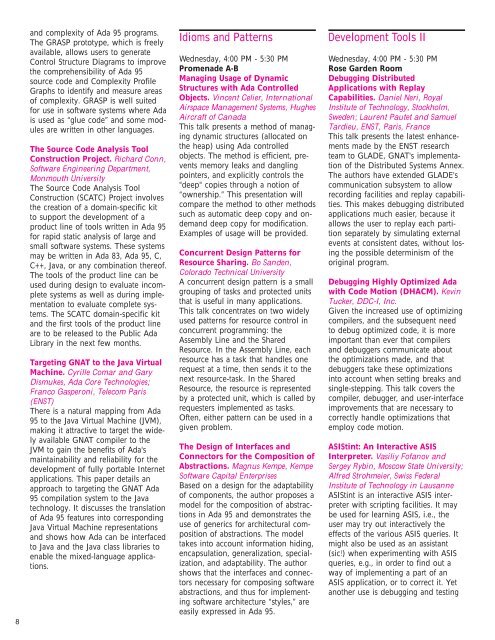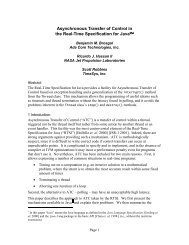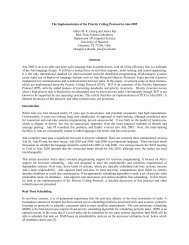AP 20 Pages-rc (Page 1) - SIGAda
AP 20 Pages-rc (Page 1) - SIGAda
AP 20 Pages-rc (Page 1) - SIGAda
Create successful ePaper yourself
Turn your PDF publications into a flip-book with our unique Google optimized e-Paper software.
8<br />
and complexity of Ada 95 programs.<br />
The GRASP prototype, which is freely<br />
available, allows users to generate<br />
Control Structure Diagrams to improve<br />
the comprehensibility of Ada 95<br />
sou<strong>rc</strong>e code and Complexity Profile<br />
Graphs to identify and measure areas<br />
of complexity. GRASP is well suited<br />
for use in software systems where Ada<br />
is used as “glue code” and some modules<br />
are written in other languages.<br />
The Sou<strong>rc</strong>e Code Analysis Tool<br />
Construction Project. Richard Conn,<br />
Software Engineering Department,<br />
Monmouth University<br />
The Sou<strong>rc</strong>e Code Analysis Tool<br />
Construction (SCATC) Project involves<br />
the creation of a domain-specific kit<br />
to support the development of a<br />
product line of tools written in Ada 95<br />
for rapid static analysis of large and<br />
small software systems. These systems<br />
may be written in Ada 83, Ada 95, C,<br />
C++, Java, or any combination thereof.<br />
The tools of the product line can be<br />
used during design to evaluate incomplete<br />
systems as well as during implementation<br />
to evaluate complete systems.<br />
The SCATC domain-specific kit<br />
and the first tools of the product line<br />
are to be released to the Public Ada<br />
Library in the next few months.<br />
Targeting GNAT to the Java Virtual<br />
Machine. Cyrille Comar and Gary<br />
Dismukes, Ada Core Technologies;<br />
Franco Gasperoni, Telecom Paris<br />
(ENST)<br />
There is a natural mapping from Ada<br />
95 to the Java Virtual Machine (JVM),<br />
making it attractive to target the widely<br />
available GNAT compiler to the<br />
JVM to gain the benefits of Ada's<br />
maintainability and reliability for the<br />
development of fully portable Internet<br />
applications. This paper details an<br />
approach to targeting the GNAT Ada<br />
95 compilation system to the Java<br />
technology. It discusses the translation<br />
of Ada 95 features into corresponding<br />
Java Virtual Machine representations<br />
and shows how Ada can be interfaced<br />
to Java and the Java class libraries to<br />
enable the mixed-language applications.<br />
Idioms and Patterns<br />
Wednesday, 4:00 PM - 5:30 PM<br />
Promenade A-B<br />
Managing Usage of Dynamic<br />
Structures with Ada Controlled<br />
Objects. Vincent Celier, International<br />
Airspace Management Systems, Hughes<br />
Ai<strong>rc</strong>raft of Canada<br />
This talk presents a method of managing<br />
dynamic structures (allocated on<br />
the heap) using Ada controlled<br />
objects. The method is efficient, prevents<br />
memory leaks and dangling<br />
pointers, and explicitly controls the<br />
"deep" copies through a notion of<br />
“ownership.” This presentation will<br />
compare the method to other methods<br />
such as automatic deep copy and ondemand<br />
deep copy for modification.<br />
Examples of usage will be provided.<br />
Concurrent Design Patterns for<br />
Resou<strong>rc</strong>e Sharing. Bo Sanden,<br />
Colorado Technical University<br />
A concurrent design pattern is a small<br />
grouping of tasks and protected units<br />
that is useful in many applications.<br />
This talk concentrates on two widely<br />
used patterns for resou<strong>rc</strong>e control in<br />
concurrent programming: the<br />
Assembly Line and the Shared<br />
Resou<strong>rc</strong>e. In the Assembly Line, each<br />
resou<strong>rc</strong>e has a task that handles one<br />
request at a time, then sends it to the<br />
next resou<strong>rc</strong>e-task. In the Shared<br />
Resou<strong>rc</strong>e, the resou<strong>rc</strong>e is represented<br />
by a protected unit, which is called by<br />
requesters implemented as tasks.<br />
Often, either pattern can be used in a<br />
given problem.<br />
The Design of Interfaces and<br />
Connectors for the Composition of<br />
Abstractions. Magnus Kempe, Kempe<br />
Software Capital Enterprises<br />
Based on a design for the adaptability<br />
of components, the author proposes a<br />
model for the composition of abstractions<br />
in Ada 95 and demonstrates the<br />
use of generics for a<strong>rc</strong>hitectural composition<br />
of abstractions. The model<br />
takes into account information hiding,<br />
encapsulation, generalization, specialization,<br />
and adaptability. The author<br />
shows that the interfaces and connectors<br />
necessary for composing software<br />
abstractions, and thus for implementing<br />
software a<strong>rc</strong>hitecture “styles,” are<br />
easily expressed in Ada 95.<br />
Development Tools II<br />
Wednesday, 4:00 PM - 5:30 PM<br />
Rose Garden Room<br />
Debugging Distributed<br />
Applications with Replay<br />
Capabilities. Daniel Neri, Royal<br />
Institute of Technology, Stockholm,<br />
Sweden; Laurent Pautet and Samuel<br />
Tardieu, ENST, Paris, France<br />
This talk presents the latest enhancements<br />
made by the ENST resea<strong>rc</strong>h<br />
team to GLADE, GNAT's implementation<br />
of the Distributed Systems Annex.<br />
The authors have extended GLADE's<br />
communication subsystem to allow<br />
recording facilities and replay capabilities.<br />
This makes debugging distributed<br />
applications much easier, because it<br />
allows the user to replay each partition<br />
separately by simulating external<br />
events at consistent dates, without losing<br />
the possible determinism of the<br />
original program.<br />
Debugging Highly Optimized Ada<br />
with Code Motion (DHACM). Kevin<br />
Tucker, DDC-I, Inc.<br />
Given the increased use of optimizing<br />
compilers, and the subsequent need<br />
to debug optimized code, it is more<br />
important than ever that compilers<br />
and debuggers communicate about<br />
the optimizations made, and that<br />
debuggers take these optimizations<br />
into account when setting breaks and<br />
single-stepping. This talk covers the<br />
compiler, debugger, and user-interface<br />
improvements that are necessary to<br />
correctly handle optimizations that<br />
employ code motion.<br />
ASIStint: An Interactive ASIS<br />
Interpreter. Vasiliy Fofanov and<br />
Sergey Rybin, Moscow State University;<br />
Alfred Strohmeier, Swiss Federal<br />
Institute of Technology in Lausanne<br />
ASIStint is an interactive ASIS interpreter<br />
with scripting facilities. It may<br />
be used for learning ASIS, i.e., the<br />
user may try out interactively the<br />
effects of the various ASIS queries. It<br />
might also be used as an assistant<br />
(sic!) when experimenting with ASIS<br />
queries, e.g., in order to find out a<br />
way of implementing a part of an<br />
ASIS application, or to correct it. Yet<br />
another use is debugging and testing










